Automotive industry in India
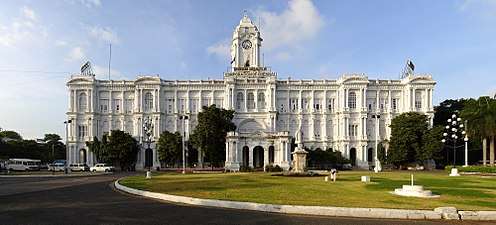
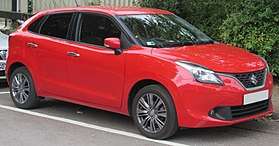
The automotive industry in India is one of the largest in the world with an annual production of 23.96 million vehicles in FY (fiscal year) 2015–16, following a growth of 2.57 per cent over the last year. The automobile industry accounts for 7.1 per cent of the country's gross domestic product (GDP). The Two Wheelers segment, with 81 per cent market share, is the leader of the Indian Automobile market, owing to a growing middle class and a young population. Moreover, the growing interest of companies in exploring the rural markets further aided the growth of the sector. The overall Passenger Vehicle (PV) segment has 13 per cent market share.
India is also a prominent auto exporter and has strong export growth expectations for the near future. In FY 2014–15, automobile exports grew by 15 per cent over the last year. In addition, several initiatives by the Government of India and the major automobile players in the Indian market are expected to make India a leader in the Two Wheeler (2W) and Four Wheeler (4W) market in the world by 2020.[1]
Market size
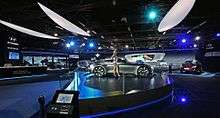
The industry produced a total 14.25 million vehicles—including passenger vehicles (PV), commercial vehicles (CV), and three- and two wheelers (3W and 2W)—in April–October 2015, as against 13.83 in April–October 2014, registering a marginal growth of 3.07 per cent, year-to-year.
The sales of PVs grew by 8.51 per cent in April–October 2015 over the same period in the previous year. The overall CVs segment registered a growth of 8.02 per cent in April–October 2015 as compared to same period last year. Medium- and heavy commercial vehicles (MCV and HCV) registered very strong growth of 32.3 per cent, while sales of light commercial vehicles (LCV) declined by 5.24 per cent during April–October 2015, year-to-year.
In April–October 2015, overall automobile exports grew by 5.78 per cent. PVs, CVs, 3Ws, and 2Ws registered growth of 6.34 per cent, 17.95 per cent, 18.59 per cent, and 3.22 per cent, respectively, in April–October 2015, over April–October 2014.[2]
Investments

In order to keep up with the growing demand, several auto makers have started investing heavily in various segments of the industry during the last few months. The industry has attracted foreign direct investment (FDI) worth US$17.4 billion during the period April 2000 to June 2017, according to data released by Department of Industrial Policy and Promotion (DIPP).
Some of the major investments and developments in the automobile sector in India are as follows:
- Global auto maker Ford plans to manufacture in India two families of engines by 2017, a 2.2 litre diesel engine code-named Panther, and a 1.2 litre petrol engine code-named Dragon, which are expected to power 270,000 Ford vehicles globally.
- The world's largest air bag suppliers Autoliv Inc, Takata Corp, TRW Automotive Inc and Toyoda Gosei Co are setting up plants and increasing capacity in India.[3]
- General Motors plans to invest US$1 billion in India by 2020, mainly to increase the capacity at the Talegaon plant in Maharashtra from 130,000 units a year to 220,000 by 2025.
- US-based car maker Chrysler has planned to invest Rs 3,500 crore (US$525 million) in Maharashtra, to manufacture Jeep Grand Cherokee model.
- Mercedes Benz has decided to manufacture the GLA entry SUV in India. The company has doubled its India assembly capacity to 20,000 units per annum.
- Germany-based luxury car maker Bayerische Motoren Werke AG's (BMW) local unit has announced to procure components from seven India-based auto parts makers.
- Mahindra Two Wheelers Limited (MTWL) acquired 51 per cent shares in France-based Peugeot Motorcycles (PMTC).[2]
Government Initiatives
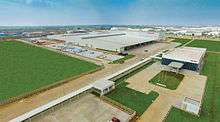
The Government of India encourages foreign investment in the automobile sector and allows 100 per cent FDI under the automatic route.
Some of the major initiatives taken by the Government of India are:
- The Government of India aims to make automobile manufacturing the main driver of "Make in India" initiative, as it expects the passenger vehicles market to triple to 9.4 million units by 2026, as highlighted in the Auto Mission Plan (AMP) 2016-26.
- In the Union budget of 2015-16, the Government has announced plans to provide credit of Rs 850,000 crore (US$127.5 billion) to farmers, which is expected to boost sales in the tractors segment.
- The government plans to promote eco-friendly cars in the country—i.e. CNG-based vehicles, hybrid vehicles, and electric vehicles—and also to make mandatory 5 per cent ethanol blending in petrol.
- The government has formulated a Scheme for Faster Adoption and Manufacturing of Electric and Hybrid Vehicles in India, under the National Electric Mobility Mission 2020, to encourage the progressive introduction of reliable, affordable, and efficient electric and hybrid vehicles into the country.
- The Automobile Mission Plan (AMP) for the period 2006–2016, designed by the government is aimed at accelerating and sustaining growth in this sector. Also, the well-established Regulatory Framework under the Ministry of Shipping, Road Transport and Highways, plays a part in providing a boost to this sector.[4]
History
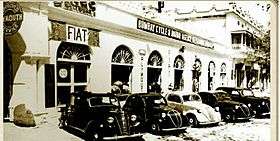
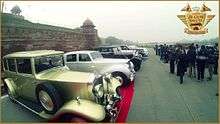

In 1897, the first car ran on an Indian road. Through the 1930s, cars were imports only, and in small numbers.
An embryonic automotive industry emerged in India in the 1940s. Hindustan Motors was launched in 1942, long-time competitor Premier in 1944, building Chrysler, Dodge, and Fiat products respectively.[5] Mahindra & Mahindra was established by two brothers in 1945, and began assembly of Jeep CJ-3A utility vehicles. Following independence in 1947, the Government of India and the private sector launched efforts to create an automotive-component manufacturing industry to supply to the automobile industry. In 1953, an import substitution programme was launched, and the import of fully built-up cars began to be restricted.[5]
1947-1970

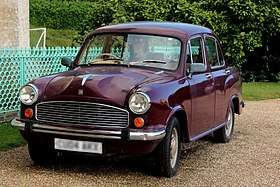
The 1952 Tariff Commission
In 1952, the government appointed the first Tariff Commission, one of whose purposes was to come out with a feasibility plan for the indigenization of the Indian automobile industry. In 1953, the commission submitted their report, which recommended categorizing existing Indian car companies according to their manufacturing infrastructure, with licensed capacity to manufacture a certain number of vehicles, with capacity increases allowable, as per demands, in the future. The Tariff Commission recommendations were implemented with new policies that would eventually exclude companies that only imported parts for assembly, as well as those with no Indian partner. In 1954, following the Tariff Commission implementation, General Motors, Ford, and Rootes Group, which had assembly-only plants in Mumbai, decided to move out of India.[6]
The Tariff commission policies, including similar restrictions that applied to other industries, came to be known as the "license raj", which proved to be the greatest undoing of the Indian automotive industry, where bureaucratic red tape ended up causing demand to outstrip supply, with month-long waiting periods for cars, scooters, and motorcycles.
Passenger Cars
- Hindustan Motors, Calcutta - technical collaboration with Morris Motors to manufacture Morris Oxford models that would later become HM Ambassador.
- Addison's - An Amalgamations Group company, was the agent for Nuffield's Morris, Wolseley, and Riley cars, and Chrysler’s Plymouth, Dodge, and De Soto cars and trucks. The first Morris Minor assembled in India and the first car assembled in Madras was driven out from Addison’s twin-plants on Smith Road by Anantharamakrishnan on November 15, 1950.[7]
- Premier Automobiles, Bombay - technical collaboration with Chrysler to manufacture Dodge, Plymouth and Desoto models and with Fiat to manufacture the 1100D models which would later with Premier Padmini range.
- Standard Motor Products of India, Madras - technical collaboration from Standard-Triumph to manufacture Standard Vanguard, Standard 8, 10 and later Standard Herald.
Utility and Light Commercial Vehicles
- Vehicle Factory Jabalpur - started manufacturing Jonga Light Utility Vehicles and Vahan 1 Ton (Nissan 4W73 Carriers) in India, under license from Nissan of Japan. They were the main troop carriers of the Indian Armed Forces and much powerful than any other vehicle of their class.
- Mahindra & Mahindra, Bombay - technical collaboration with Willys to manufacture CJ Series Jeep.
- Bajaj Tempo, Poona now Force Motors - technical collaboration with Tempo (company) to manufacture Tempo Hanseat, a three-wheeler and Tempo Viking and Hanomag, later known as Tempo Matador in India.
- Standard Motor Products of India - technical collaboration from Standard has licence to manufacture the Standard Atlas passenger van with panel van and one-tonne one tonne pickup variants.
Medium and Heavy Commercial Vehicles
- Vehicle Factory Jabalpur - started manufacturing Shaktiman trucks with technical assistance from MAN SE of Germany. The trucks were the main logistics vehicle of the Indian Army with several specialist variants. VFJ still is the sole supplier of B vehicles to the Indian Armed Forces.
- Heavy Vehicles Factory - was established in 1965 in Avadi, near Chennai to produce tanks in India. Since its inception, HVF has produced all the tanks of India, including Vijayanta, Arjun, Ajeya, Bhishma and their variants for the Indian Army. HVF is the only tank manufacturing facility of India.
- Tata Motors, Poona, then known as TELCO - technical collaboration with Mercedes Benz to manufacture medium to heavy commercial vehicles both Bus and Trucks.
- Ashok Motors, later Ashok Leyland, Madras - technical collaboration with Leyland Motors to manufacture medium to heavy commercial vehicles both Bus and Trucks. Ashok Motors also discontinued its Austin venture formed in 1948 to sell Austin A40 and retooled the factory to make trucks and buses.
- Hindustan Motors - technical collaboration with General Motors to manufacture the Bedford range of medium lorry and bus chassis.
- Premier Automobiles - technical collaboration with Chrysler to manufacture the Dodge, Fargo range of medium lorry, panel vans, mini-bus and bus chassis.
- Simpsons & Co, Madras - part of Amalgamations Group (TAFE Tractors)- technical collaboration with Ford to manufacture medium lorry and bus chassis, but did not utilise that option until the 1980s.
Scooters, Mopeds and Motorcycles
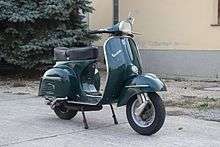
known as Bajaj Chetak, by Bajaj became the largest sold scooter in the world
- Many of the two-wheelers manufacturers were granted licenses in the early 1960s, well after the tariff commission was enabled.
- Royal Enfield (India), Madras - technical collaboration with Royal Enfield, UK to manufacture the Enfield Bullet range of motorcycles.
- Bajaj Auto, Poona - technical collaboration with Piaggio, Italy to manufacture their best selling Vespa range of scooters and three wheelers with commercial option as well.
- Automobile Products of India, Bombay (Better known for API Lambretta - technical collaboration with Innocenti of Milan, Italy to manufacture their Lambretta range of mopeds, scooters and three-wheelers. This company was actually the Rootes Group car plant that was bought over by M. A. Chidambaram family.
- Mopeds India Limited, Tirupathi - technical collaboration with Motobécane, France to manufacture their best selling Mobylette mopeds.
- Escorts Group, New Delhi - technical collaboration with CEKOP of Poland to manufacture the Rajdoot 175 motorcycle whose origin was DKW RT 125
- Ideal Jawa, Mysore - in technical collaboration with CZ - Jawa of Czechoslovakia for its Jawa and Yezdi range of motorcycles.
1970 to 1983
However, growth was relatively slow in the 1950s and 1960s, due to nationalisation and the license raj, hampering the growth of Indian private sector.
The beginning of the 1970s saw some growth potential and most of the collaboration license agreements came to an end but with option to continue manufacturing with renewed branding. Cars were still meant for the elite and Jeeps were largely used by government organizations and some rural belts. In commercial vehicle segments some developments were made by the end of the decade to cater improved goods movements. The two-wheeler segment remained unchanged except for to increased sales in urban among middle class. But more fillip was target towards farm tractors as India was embarking on a new Green Revolution. More Russian and eastern bloc imports were done to increase the demand.
But after 1970, with restrictions on the import of vehicles set, the automotive industry started to grow; but the growth was mainly driven by tractors, commercial vehicles and scooters. Cars still remained a major luxury item. In the 1970s, price controls were finally lifted, inserting a competitive element into the automobile market.[8] However, by the 1980s, the automobile market was still dominated by Hindustan and Premier, who sold superannuated products in fairly limited numbers.[9] During the eighties, a few competitors began to arrive on the scene.
The OPEC oil crisis saw increase need to installing or redesign some vehicle to fit diesel engines on medium commercial vehicle. Until the early 1970s Mahindra Jeeps were on Petrol and Premier commercial vehicles had Petrol model options. The Defence sector too had most trucks on Pertol engines.
1984 to 1992
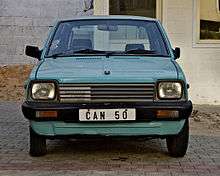
From the end of the 1970s to the beginning of the 1980s saw no new models but the country continued with 2 decade old designs forcing government to encourage and let more manufacturers into fray.
In 1984, the then Prime Minister of India, Indira Gandhi established the Ordnance Factory Medak, near Hyderabad. It started manufacturing Infantry Combat Vehicles christened as Sarath, the backbone of India's mechanised infantry. OFMK is still the only manufacturing facility of ICVs in India. To manufacture the high-power engines used in ICVs and main battle tanks, Engine Factory Avadi, near Chennai was set in 1987. In 1986, to promote the auto industry, the government established the Delhi Auto Expo. The 1986 Expo was a showcase for how the Indian automotive industry was absorbing new technologies, promoting indigenous research and development, and adapting these technologies for the rugged conditions of India. The nine-day show was attended by then Prime Minister Rajiv Gandhi.
Post-1992 liberalisation
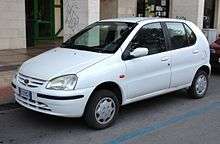
.jpg)

Eventually multinational automakers, such as, Suzuki and Toyota of Japan and Hyundai of South Korea, were allowed to invest in the Indian market, furthering the establishment of an automotive industry in India. Maruti Suzuki was the first, and the most successful of these new entries, and in part the result of government policies to promote the automotive industry beginning in the 1980s.[9] As India began to liberalise its automobile market in 1991, a number of foreign firms also initiated joint ventures with existing Indian companies. The variety of options available to the consumer began to multiply in the nineties, whereas before there had usually only been one option in each price class. By 2000, there were 12 large automotive companies in the Indian market, most of them offshoots of global companies.[10]
Slow export growth
Exports were slow to grow. Sales of small numbers of vehicles to tertiary markets and neighbouring countries began early, and in 1987 Maruti Suzuki shipped 480 cars to Europe (Hungary). After some growth in the mid-nineties, exports once again began to drop as the outmoded platforms provided to Indian manufacturers by multinationals were not competitive.[11] This was not to last, and today India manufactures low-priced cars for markets across the globe. As of 18 March 2013, global brands such as Proton Holdings, PSA Group, Kia, Mazda, Chrysler, Dodge and Geely Holding Group were shelving plans for India due to the competitiveness of the market, as well as the global economic crisis.[12]
Emission norms
In 2000, in line with international standards to reduce vehicular pollution, the central government unveiled standards titled "India 2000", with later, upgraded guidelines to be known as Bharat Stage emission standards. These standards are quite similar to the stringent European emission standards and have been implemented in a phased manner. Bharat Stage IV (BS-IV), the most stringent so far, was implemented first, in April 2010, in 13 cities—Delhi (NCR), Mumbai, Kolkata, Chennai, Bangalore, Hyderabad, Ahmedabad, Pune, Surat, Kanpur, Lucknow, Solapur, and Agra—and then, as of April 2017, the rest of the nation.
Local manufacture encouraged
India levies an import tax of 125% on foreign imported cars, while the import tax on components such as gearboxes, airbags, drive axles, is 10%. Therefore, the taxes encourage cars to be assembled in India rather than be imported as completely built units.[13]
Manufacturing facilities
The majority of India's car manufacturing industry is evenly divided into three "clusters". Around Chennai is the southernmost and largest, with a 35% revenue share, accounting for 60% of the country's automotive exports, and home of the operations of Heavy Vehicles Factory, Engine Factory Avadi, Ford, Hyundai, Renault, Mitsubishi, Nissan, BMW, Hindustan Motors, Daimler, Caparo, Mini, and Datsun.[14][15]
Near Mumbai, Maharashtra, along the Chakan corridor near Pune, is the western cluster, with a 33% share of the market. Audi, Volkswagen, and Skoda are located in Aurangabad. Mahindra and Mahindra has an SUV and engine assembly plant at Nashik. General Motors, Tata Motors, Mercedes Benz, Land Rover, Jaguar, Fiat, and Force Motors have assembly plants in the area.[16][17]
The northern cluster is around the National Capital Region, and contributes 32%. Gurgaon and Manesar, in Haryana, are where the country's largest car manufacturer, Maruti Suzuki, is based.
An emerging cluster is the state of Gujarat, with a manufacturing facility of General Motors in Halol, and a facility for Tata Nano at their plant in Sanand. Ford, Maruti Suzuki, and Peugeot-Citroen plants are also planned for Gujarat.[18]
Kolkata with Hindustan Motors (inactive), Noida with Honda, and Bengaluru with Toyota are other automotive manufacturing regions around the country.[19][20][21]
Andhra Pradesh
- Commercial and passenger vehicles
- Two wheelers
- Off-highway vehicles
.jpg)
Gujarat
- Passenger vehicles
- General Motors India Private Limited
- Tata Motors – Sanand[23]
- Ford India – Sanand.
- Maruti Suzuki – Ahmedabad
- Commercial vehicles
Haryana
- Two wheelers
- Harley-Davidson India, Bawal[25]
- Hero MotoCorp – Dharuhera, Gurgaon[26]
- Honda Motorcycle & Scooter India – Manesar[27]
- India Yamaha Motor – Faridabad,[28] Manesar[29]
- Suzuki – Gurgaon[30]
- Passenger vehicles
Himachal Pradesh
- Two wheelers
- Passenger vehicles
- Commercial vehicles
Jharkhand
- Commercial vehicles
Karnataka
- Two wheelers
- Passenger vehicles
- Mahindra Reva Electric Vehicles – Bengaluru[35]
- Toyota Kirloskar Motor Private Limited – Bidadi[36]
- Commercial vehicles
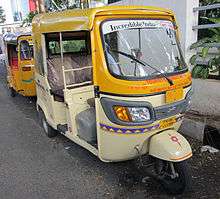

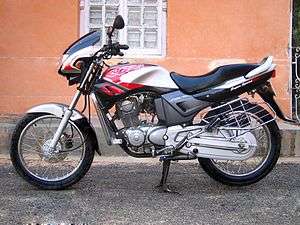
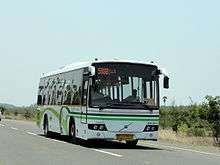
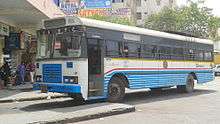
.jpg)

Kerala
- Commercial vehicles
- Bharat Earth Movers Defense Products - produces Tatra Trucks 12x12, 10x10,8x8, 6x6, 4x4, and variants
- Kerala Automobiles Limited
Madhya Pradesh
- Two wheelers
- Commercial vehicles
Maharashtra
- Two wheelers
- Bajaj Auto – Chakan, Pune & Waluj, Aurangabad[46]
- KTM Sportmotorcycles – Chakan, Pune
- India Kawasaki Motors – Chakan, Pune
- Vespa Scooters – Baramati[47]
- Kinetic Engineering – Ahmednagar[48]
- DSK Hysoung - Wai
- Passenger vehicles
- Mahindra & Mahindra Automotive Division – Nashik, Chakan, Pune[49][50]
- Ssangyong Motor Company – Chakan, Pune[51]
- Tata Motors Limited
- Mercedes-Benz Passenger Cars – Chakan, Pune[54]
- Fiat Automobiles – Ranjangaon, Pune[55]
- Jeep India – Ranjangaon, Pune
- General Motors India – Talegaon, Pune)[56]
- Volkswagen Group Sales India Private Limited
- Chinkara Motors – Karlekhind, Alibag[60]
- Premier Automobiles Limited – Pimpri Chinchwad, Pune[61]
- Commercial vehicles
- Ashok Leyland – Bhandara[62]
- Bajaj Auto – Waluj, Aurangabad[46]
- Force Motors – Chakan, Pune[63]
- Mahindra Navistar – Chakan, Pune[64]
- MAN Trucks India – Akurdi, Pune[65]
- Piaggio Vehicles – Baramati[66]
- Premier Automobiles Limited – Pimpri Chinchwad, Pune[61]
- Eicher (VE Commercial Vehicles Ltd.) – Thane.
- Sany India – Pune.
- Hyundai Construction Equipment – Chakan (Pune).
- Terex – Khed, Pune.
- Caterpillar - Banda.
Punjab
- Commercial vehicles
- SML Isuzu Limited – Nawanshahar[67] (originally a Swaraj Mazda plant).
- Preet Tractor, Nabha.
- Sonalika Tractor Pvt Ltd, Hoshiarpur.
Rajasthan
- Two Wheelers
Honda Motorcycle & Scooter India – Tapukara[27]
- Passenger vehicles
- Commercial vehicles
Tamil Nadu
- Two wheelers
- Passenger vehicles
- BMW India – Mahindra World City, New Chennai[70][71]
- Ford India Private Limited – Maraimalai Nagar, Chennai[72]
- Hyundai Motor India Limited – Sriperumbudur, Chennai[73]
- Mitsubishi – Tiruvallur, Chennai[43]
- Renault Nissan Automotive India Private Limited
- Commercial vehicles
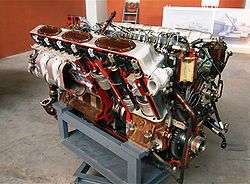
- Heavy Vehicles Factory, Avadi, Chennai
- Engine Factory Avadi, Avadi, Chennai
- Ashok Leyland – EnnoreChennai, Hosur[62]
- BharatBenz – Oragadam, Chennai[76]
- Kamaz Vectra Motors – Hosur[77]
- SAME Deutz-Fahr Tractors – Ranipet, Vellore[78]
- TAFE Tractors – Chennai[34]
- TVS Motor – Hosur[32]
Telangana
- Defence
- Commercial vehicles
Uttar Pradesh
- Two wheelers
- Passenger vehicles
- Honda Cars India Ltd. – Greater Noida[80]
- J.S. Auto (P) LTD. – Kanpur[81]
- Commercial vehicles
Uttarakhand
- Commercial vehicles
- Two wheelers
West Bengal
- Passenger vehicles
- Hindustan Motors Limited – Kolkata (Inactive)
- Commercial vehicles
Exports

India's automobile exports have grown consistently and reached $4.5 billion in 2009, with the United Kingdom being India's largest export market, followed by Italy, Germany, Netherlands, and South Africa.[82]
According to The New York Times, India's strong engineering base and expertise in the manufacturing of low-cost, fuel-efficient cars has resulted in the expansion of manufacturing facilities of several automobile companies like Hyundai, Nissan, Toyota, Volkswagen, and Maruti Suzuki.[83]
In 2008, South Korean multinational Hyundai Motors alone exported 240,000 cars made in India. Nissan Motors plans to export 250,000 vehicles manufactured in its India plant by 2011.[84] Similarly, US automobile company, General Motors announced its plans to export about 50,000 cars manufactured in India by 2011.[85]
In September 2009, Ford Motors announced its plans to set up a plant in India with an annual capacity of 250,000 cars, for US$500 million. The cars will be manufactured both for the Indian market and for export.[86] The company said that the plant was a part of its plan to make India the hub for its global production business.[87] Fiat Motors announced that it would source more than US$1 billion worth auto components from India.[88]
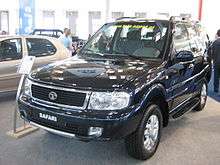
In 2009 India (0.23m) surpassed China (0.16m) as Asia's fourth largest exporter of cars after Japan (1.77m), Korea (1.12m) and Thailand (0.26m).[89]
In July 2010, The Economic Times reported that PSA Peugeot Citroën was planning to re-enter the Indian market and open a production plant in Andhra Pradesh that would have an annual capacity of 100,000 vehicles, investing € 700M in the operation.[90] PSA's intention to utilise this production facility for export purposes however remains unclear as of December 2010.
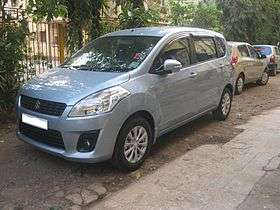
In recent years, India has emerged as a leading center for the manufacture of small cars. Hyundai, the biggest exporter from the country, now ships more than 250,000 cars annually from India. Apart from Maruti Exports' shipments to Suzuki's other markets, Maruti Suzuki also manufactures small cars for Nissan, which sells them in Europe. Nissan will also export small cars from its new Indian assembly line. Tata Motors exports its passenger vehicles to Asian and African markets, and is preparing to sell electric cars in Europe in 2010. The firm is planning to sell an electric version of its affordable car the Tata Nano in Europe and in the U.S. Mahindra & Mahindra is preparing to introduce its pickup trucks and small SUV models in the U.S. market. Bajaj Auto is designing a low-cost car for Renault Nissan Automotive India, which will market the product worldwide. Renault Nissan may also join domestic commercial vehicle manufacturer Ashok Leyland in another small car project.[91] While the possibilities for the Indian automobile industry are impressive, there are challenges that could thwart future growth. Since the demand for automobiles in recent years is directly linked to overall economic expansion and rising personal incomes, industry growth will slow if the economy weakens.[91]
Top 10 export destinations
India exported $14.5 billion worth of automobiles in 2014. The 10 countries below imported 47.8% of that total.[92]
| Rank | Country | Value (US$) | Share |
|---|---|---|---|
| 1 | United States | 1.2 billion | 8.4% |
| 2 | Mexico | $1 billion | 6.9% |
| 3 | South Africa | $888.8 million | 6.1% |
| 4 | United Kingdom | $637.4 million | 4.4% |
| 5 | Sri Lanka | $596.9 million | 4.1% |
| 6 | Bangladesh | $592.1 million | 4.1% |
| 7 | Turkey | $580.4 million | 4% |
| 8 | Nigeria | $546.8 million | 3.8% |
| 9 | United Arab Emirates | $433.6 million | 3% |
| 10 | Colombia | $428.9 million | 3% |
Passenger vehicles in India
This list is of cars that are officially available and serviced in India. While other cars can be imported to the country at a steep 105% import duty, car-makers such as Alfa Romeo,[93] McLaren,[94] Pagani,[95] Cadillac,[96] Chrysler,[97] SSC,[98] Lincoln,[99] Zenvo,[100] SEAT,[101] Smart,[102] Daihatsu,[103] Infiniti,[104] Acura,[105] Saab,[106] Spyker,[107] Lotus,[108] Ariel,[109] Caterham,[110] Peugeot-Citroën,[111] Mazda,[112] Kia,[113] GAZ,[114] and Proton[115] are in various stages of official introduction into the Indian automobile industry.
Indian automotive companies
Models currently manufactured by Indian companies

- Chinkara Motors:[116] Beachster, Hammer, Roadster 1.8S, Rockster, Jeepster, Sailster
- Force Motors (earlier known as Tempo): One
- Hindustan Motors:[117] Ambassador
- Hradyesh:[118]Morris Street[119]
- ICML:[120] Rhino Rx
- Mahindra:[121]Bolero, Scorpio, Thar, Xylo, Quanto, Verito, Verito Vibe, Genio, XUV500, e2o, TUV300, KUV100, NuvoSport.
- Premier Automobiles Limited:[122] Sigma, RiO
- San Motors:[123] Storm
- Maruti Suzuki (subsidiary of Japanese auto maker Suzuki)[124][125] Alto K10, Alto 800, WagonR, Swift, DZire, Omni, Eeco, Gypsy, Ertiga, Celerio, Ciaz, Vitara Brezza, Baleno, Ignis, S-Cross.
- Tata Motors:[126] Nano, Sumo, Movus, Venture, Safari, Xenon, Zest, Bolt, Tiago, Tigor, Hexa, Nexon.
Defunct Indian automotive companies
Foreign automotive companies in India
Hyundai, Renault, Nissan, Datsun, Mitsubishi, Ford, Fiat, Honda, Toyota, Volkswagen, Skoda, Audi, Jaguar, Land Rover, Mercedes-Benz, BMW and MINI are the foreign automotive companies that manufacture and market their products in India.
Vehicles currently manufactured or assembled in India
- Audi India: A3, A4, A6, A8, Q3, Q5, Q7.
- BMW India:[127] 1 Series, 3 Series, 3 Series GT, 5 Series, 7 Series, X1, X3, X5.
- Datsun: Go, Go+, Redi-Go
- Fiat India: Punto, Linea, Avventura, Urban Cross.
- Ford India:[128] Figo, Figo Aspire, Freestyle, Ecosport, Endeavour.
- Honda Cars India Limited:[129] Brio, Jazz, Amaze, BR-V, City, WR-V.
- Hyundai Motor India:[130] Eon, i10, i20, Xcent, Verna, Elantra, Creta, Tucson.
- Isuzu:[131][132] MU-7, V-Cross.
- Jaguar (Subsidiary of Tata Motors):[133] XE, XF, XJ.
- Jeep India: Compass.
- Land Rover (Subsidiary of Tata Motors):[134] Discovery Sport, Range Rover Evoque.
- Mercedes-Benz India:[135] A-Class, C-Class, E-Class, GLA-Class, GLE-Class, GLC-Class, S-Class.
- MINI:[136] Countryman.
- Mitsubishi[137] (in collaboration with Hindustan Motors):[138]Pajero.
- Nissan Motor India:[139] Micra, Sunny, Terrano.
- Renault India:[140][141][142] Captur, Duster, Kwid, Lodgy.
- Škoda Auto India:[143][144] Rapid, Octavia, Superb, Kodiaq.
- Toyota Kirloskar:[145] Etios Liva, Etios, Corolla Altis, Innova Crysta, Fortuner, Camry.
- Volkswagen India:[146][147] Polo, Vento, Ameo, Tiguan, Passat.
Opel was present in India until 2006. As of 2013, Opel only provides spare parts and vehicle servicing to existing Opel vehicle owners.
Vehicles currently imported into India
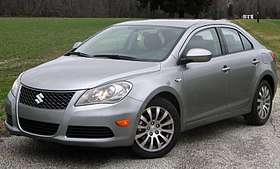
- Aston Martin:[148] Vantage, Vanquish, Rapide, Virage, DB9, DBS, One-77.
- Audi:[149] A8 L, A7, A5, TT, RS 6 Avant, R8.
- Bentley:[150][151] Arnage, Azure, Brooklands, Continental GT, Continental Flying Spur, Mulsanne.
- BMW:[152] 5 Series GT, 6 Series, 7 Series, X5 M, X6, X6 M, M3, M5, M6 and Z4.
- Bugatti:[153][154] Veyron.
- Ferrari:[155][156] California, 458 Italia, F12, FF.
- Fiat: Abarth 595 Competizone
- Ford:[157] Mustang.
- General Motors:[158] Hummer H2, Hummer H3.
- Gumpert:[159] Apollo.
- Honda:[160][161] Accord Hybrid.
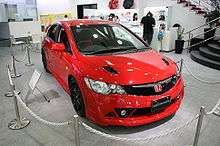
- Jaguar (Subsidiary of Tata Motors):[133] XK, F-Type
- Koenigsegg:[162][163] CCX, CCXR, Agera.
- Lamborghini:[164] Huracan, Aventador.
- Land Rover (Subsidiary of Tata Motors):[134] Discovery 4, Range Rover Velar, Range Rover Sport, Range Rover.
- Maserati:[165] Quattroporte, Ghibli.
- Mercedes-Benz:[166] Viano.
- MINI:[136] Cooper, Cooper S, Convertible.
- Mitsubishi: Montero.
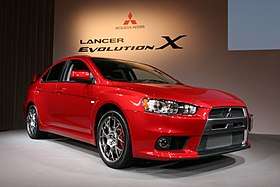
- Nissan:GT-R.
- Porsche:[167][168] 997, Boxster, Panamera, Cayman, Cayenne, Carrera GT, Macan.
- Rolls Royce:[169] Ghost, Wraith, Phantom, Phantom Coupé, Phantom Drophead Coupé.
- SsangYong (subsidiary of Mahindra & Mahindra):[170] Rexton.
- Toyota:[145] Land Cruiser, Land Cruiser Prado, Prius.
- Volkswagen:[171] Beetle.
- Volvo:[172] V40, V90, S60, S90, XC60, XC90.
Commercial vehicle manufacturers in India
Indian brands
Joint-venture (JV) brands
- Ashok Leyland[178] - originally a JV between Ashok Motors (owned by the Hinduja Group) and Leyland Motors, now joint ventures between Ashok Leyland and Nissan Motors (Japan) for LCV's; and John Deere (USA) for construction equipment.[179]
- KaMAZ Vectra[180] - A JV between Russia's KaMAZ and the Vectra Group
- MAN Force - A JV between Force Motors and MAN AG (Germany)
- SML Isuzu - originally, as Swaraj Mazda, a JV between Punjab Tractors and Mazda, now 53.5% owned by Sumitomo Group and with its current name since 2011.[181]
- Tatra Vectra Motors Ltd - (defunct) Initial truck partnership with India by Vectra. Replaced by Kamaz. Tatra trucks for sale in India are now manufactured in collaboration with Bharat Earth Movers Limited.
- VE Commercial Vehicles Limited[182] - VE Commercial Vehicles limited - A JV between Volvo Group and Eicher Motors Limited.
- Maruti Suzuki - A joint venture of Indian Maruti and Japanese Suzuki.
Foreign-owned brands
- J. C. Bamford (JCB) (Owned by British multinational corporation J. C. Bamford).
- BharatBenz (Owned by Daimler AG of Germany and affiliated with Daimler's Fuso and Mercedes-Benz brands)[183]
- Caterpillar Inc.[184]
- DAF[185]
- Hino[186]
- Isuzu[187]
- Iveco[188]
- MAN
- Mercedes-Benz[189] - manufactures luxury coaches in India.
- Piaggio[190]
- Rosenbauer.[191]
- Scania[192]
- Tatra.[193]
- Volvo.[194]
Electric vehicle and Hybrid vehicle (xEV) industry
During April 2012, the Indian government planned to unveil the road map for the development of domestic electric and hybrid vehicles (xEV) in the country.[195] A discussion between the various stakeholders, including Government, industry, and academia, was expected to take place during 23–24 February.[195] The final contours of the policy would have been formed after this set of discussions. Ministries such as Petroleum, Finance, Road Transport, and Power are involved in developing a broad framework for the sector. Along with these ministries, auto industry executives, such as Anand Mahindra (Vice Chairman and Managing Director, Mahindra & Mahindra) and Vikram Kirloskar (Vice-Chairman, Toyota Kirloskar), were involved in this task.[195] The Government has also proposed to set up a Rs 740 crore research and development fund for the sector in the 12th five-year plan during 2012-17.[195] The idea is to reduce the high cost of key imported components such as the battery and electric motor, and to develop such capabilities locally. In the year 2017, An Amaravati, Andhra Pradesh based Electric Vehicles manufacturing company called AVERA[196] New & Renewable Energy started electric scooters manufacturing[197] and are ready to launch their two models of scooters by the end of December 2018[198].
Electric car manufacturers in India
- Ajanta Group.[199]
- Hero Electric.[200]
- Mahindra.[201]
- Reva, now Mahindra Reva Electric Vehicles.
- Tara International.[202]
- Tata Motors.[203]
Driverless Technology in India
While there is controversy on possibility of driverless cars in India,[204][205] many startups are working on this technology:
- Flux Auto
- FishEyeBox
- Hi Tech Robotic Systemz
- ATImotors
- Netradyne
- Swaayat Robots
- Auro Robotics
- OmniPresent Robotics
- SeDrica 1.0[206]
In Auto Expo 2018, Hi Tech Robotic Systemz launched an artificial intelligence-based driver behaviour sensor technology called Novus Aware in partnership with Daimler India Commercial Vehicles (DICV).[207][208]
Defunct motor vehicle manufacturers of India
- Automobile Products of India or API - founded in 1949 at Bombay (now Mumbai), by the British company Rootes Group,[209] and later bought by M. A. Chidambaram of the MAC Group from Madras (now Chennai).[209] The company manufactured Lambretta scooters, API Three Wheelers under licence from Innocenti of Italy and automobile ancillaries, notably clutch and braking systems. API's registered offices were earlier in Mumbai, later shifted to Chennai, in Tamil Nadu. The manufacturing facilities were located in Mumbai and Aurangabad in Maharashtra and in Ambattur, Chennai.[210] The company has not been operational since 2002.
- Escorts Yamaha - in 1984 Escorts formed a joint venture with Yamaha to manufacture motorcycles. In 2008 became India Yamaha Motor.
- Hero Motors is a former moped and scooter manufacturer based in Delhi, India. It is a part of multinational company Hero Group, which also currently owns Hero Motocorp (formerly Hero Honda) and Hero Cycles, among others. Hero Motors was started in the 1960s to manufacture 50cc two-stroke mopeds but gradually diversified into making larger mopeds, mokicks and scooters in the 1980s and the 1990s. Noteworthy collaborators and technical partners were Puch of Austria and Malaguti of Italy. Due to tightening emission regulations and poor sales, Hero motors have discontinued the manufacture of all gasoline powered vehicles and transformed itself into an electric two-wheeler and auto parts manufacturer.
- Ideal Jawa - motorcycle company based in Mysore, sold licensed Jawa and ČZ motorcycles beginning in 1960 under the brand name Jawa and later Yezdi.
- Kinetic Honda - a joint venture between Kinetic Engineering Limited, India and Honda Motor Company, Japan. The joint venture operated during 1984 - 1998, manufacturing 2-stroke scooters in India. In 1998, the joint venture was terminated after which Kinetic Engineering continued to sell the models under the brand name Kinetic until 2008[211] when the interests were sold to Mahindra.
- Mopeds India Limited - produces the Suvega range of Mopeds under technical collaboration with Motobécane of France.
- Standard - produced by Standard Motor Products in Madras from 1949 to 1988. Indian Standards were variations of vehicles made in the U.K. by Standard-Triumph.Standard Motor Products of India Ltd. (SMPI) was incorporated in 1948,[212] and their first product was the Vanguard, which began to be assembled in 1949. The company was dissolved in 2006 and the old plant torn down.
Automotive Research Association of India - Standards
The Government of India felt the need for a permanent agency to expedite the publication of standards and development of test facilities[213] in parallel with the work of the preparation of the standards - as the development of improved safety critical parts could be undertaken only after the publication of the standard and commissioning of test facilities. The Ministry of Surface Transport (MoST) constituted a permanent Automotive Industry Standards Committee (AISC) . The Standards prepared by AISC will be approved by the permanent CMVR Technical Standing Committee (CTSC). After approval, the Automotive Research Association of India (ARAI) [214]will publish this standard.
Intelligent Transport Systems (ITS) are globally proven systems to optimize the utilization of existing transport infrastructure and improve transportation systems in terms of efficiency, quality, comfort and safety. Having realized the potential of ITS, Government bodies and other organizations in India are presently working towards implementing various components of ITS across the country.
The first step taken for creation and implementation of ITS was holding a National Workshop titled “User Requirements for Interactive ITS Architecture”[215], which was conducted as a collaboration between SIAM and ASRTU on 26th & 27th February 2015. This was primarily focused on ITS in Public Bus Transportation. Nonetheless, the workshop helped to create the outline for “National Intelligent Transport System Architecture and Policy for Public Transport (Bus)”, which was submitted by ASRTU and SIAM to the government
In the 44th & 45th CMVR-TSC, Chairman had directed - standardization activities to be initiated on Intelligent Transportation Systems (ITS) - Vehicle Location Tracking, Camera Surveillance System and Emergency Request Button. The committee intended to extend the above user requirements to all public transportation namely –buses, taxis, etc. The current document covers the requirements for Vehicle Location Tracking and Emergency Button. The other ITS components like PIS, CCTV system, Fare collection etc. are deliberated and would be addressed in later phase and could be added as separate parts to the current document..
Based on these directions, the AISC Panel on ITS has prepared this AIS-140 titled,“Intelligent Transportation Systems (ITS) - Requirements for Public Transport Vehicle Operation”. The panel also deliberated and identified the necessary elements for an effective implementation of vehicle level ITS system.
For AIS-140 Devices, in India, connectivity to report location, and Emergency Panic Button signal is though wireless cellular connectivity. There are device focused Cellular Connectivity Offerings like 'eSIM4Things[216]' available in India, which cater to connectivity requirements of AIS-140 devices[217]. eSIM4Things[216] is fully compatible with all AIS-140 devices and with a connectivity manager and a range of tariff plans.
See also

- Automobile industry
- Automotive Industry Standards, the automotive regulations of India
- Electric vehicle industry in India
- Electronics and semiconductor manufacturing industry in India
- Lists of automobile-related articles
- List of car brands
- List of truck manufacturers
- List of motorcycle manufacturers (Category)
- List of scooters - List of scooter manufacturers
- List of countries by motor vehicle production
- List of countries by vehicles per capita
- List of Asian cars
- List of automobile manufacturers of China
- List of Japanese cars
- List of vehicle plants in India
References
- ↑ Automobile, Industry. "Automotive industry in India". www.ibef.org. Indian Brand Equity Foundation. Retrieved 31 January 2016.
- 1 2 Industry, Automotive. "Automotive Industry in India". www.ibef.org. Indian Brand Equity Foundation. Retrieved 31 January 2016.
- ↑ Shah, Aditi (12 September 2015). "Air bag makers eye boost from new India road safety rules". Reuters. Retrieved 8 July 2018.
- ↑ Industry, Automotive. "Automotive Industry in India". www.ibef.org. Indian Brand Equity Foundation. Retrieved 31 January 2016.
- 1 2 Piplai, p. 2892
- ↑ The rise of the automobile in free India, Mumbai (Bombay): Autocar Professional India
- ↑ "An opportunity missed". The Hindu. 9 June 2014. ISSN 0971-751X. Retrieved 3 July 2018.
- ↑ Bhaktavatsala Rao, C. (1993-02-20). "Structural Configurations and Strategic Investments: Indian Automobile Industry". Economic and Political Weekly. Mumbai, India: Sameeksha Trust. 28 (8/9): M21.
- 1 2 "Automobile Industry: Unconvincing Explanations". Economic and Political Weekly. Mumbai, India: Sameeksha Trust. XX (16): 669. 1985-04-20.
- ↑ Piplai, p. 2893
- ↑ Piplai, pp. 2894-2895
- ↑ "Global carmakers Proton, Peugeot, Citroen, Kia shelve India plans due to tough financial conditions - Economic Times". Articles.economictimes.indiatimes.com. 2013-03-18. Retrieved 2013-10-16.
- ↑ Mondal, Dipak (5 July 2015). "Going Native". Business Today. Retrieved 30 June 2015.
- ↑ Jayashankar Menon (11 December 2010). "South emerges largest auto cluster in India". Sulekha.com. Archived from the original on 7 July 2012. Retrieved 7 November 2011.
- ↑ "CII launches Chennai zone". The Hindu Business Line. 19 October 2007. Retrieved 28 November 2010.
- ↑ "Mahindra Chakan - News". Zigwheels. Retrieved 28 November 2010.
- ↑ "Volkswagen Inaugrates [sic] Chakan Plant!". cubi[CC]apacity. Archived from the original on 8 November 2010. Retrieved 28 November 2010.
- ↑ Pearson, David (1 September 2011). "Peugeot-Citroen to Invest €650 Million in Indian Assembly Plant". Wall Street Journal. Retrieved 2 September 2011.
- ↑ "Skoda plant commissioned near Aurangabad". Autonews.indiacar.com. Archived from the original on 9 September 2010. Retrieved 28 November 2010.
- ↑ "Cars in India,Compare Cars,Upcoming Cars in India". Carcrox.com. Archived from the original on 6 September 2016. Retrieved 12 September 2016.
- ↑ "New Cars in India - Compare Cars - Latest Cars in India". sagmart.com. Retrieved 7 March 2015.
- ↑ "Contact Us". 2010. Archived from the original on 2 January 2011. Retrieved 30 June 2015.
- 1 2 3 "Tata Motors Limited - India's Largest Automobile Company". Tatamotors.com. Archived from the original on 8 December 2013. Retrieved 2013-10-16.
- ↑ "Automobiles | HCV | Heavy Commercial Vehicles - AMW". Amwasia.com. Archived from the original on 4 January 2012. Retrieved 2013-10-16.
- ↑ "News By Industry". The Times Of India. November 2, 2010.
- ↑ Archived 21 July 2011 at the Wayback Machine.
- 1 2 3 "HMSI Factory". .honda2wheelersindia.com. Archived from the original on 28 December 2014. Retrieved 2014-12-18.
- ↑ "About us | India Yamaha Motor Pvt. Ltd". Yamaha-motor-india.com. Archived from the original on 6 October 2013. Retrieved 2013-10-16.
- ↑ "Honda". Honda2wheelersindia.com. 14 December 1999. Archived from the original on 24 October 2013. Retrieved 2013-10-16.
- ↑ Archived 29 June 2012 at the Wayback Machine.
- ↑ Archived 2 July 2012 at the Wayback Machine.
- 1 2 3 4 "TVS Motor Company". Tvsmotor.in. Retrieved 2013-10-16.
- ↑ Archived 12 March 2012 at the Wayback Machine.
- 1 2 3 4 5 6 Archived 5 May 2011 at the Wayback Machine.
- ↑ "Mahindra Reva Electric Vehicles". Mahindra.com. Retrieved 2013-10-16.
- ↑ Archived 27 April 2011 at the Wayback Machine.
- ↑ "Scania to set up assembly plant in India". Bsmotoring.com. Retrieved 2013-10-16.
- ↑ "Introduction - sales contact". Volvo Buses. Retrieved 2013-10-16.
- ↑ "VOLVO TRUCKS Factory". Volvo Trucks. Retrieved 2014-12-18.
- ↑ "Contact Us". volvoce.com. Retrieved 2014-12-18.
- ↑ "Welcome to Mahindra". Mahindra2wheelers.com. Retrieved 2013-10-16.
- ↑ "Eicher :: Eicher Motors Limited :: Home". Eicherworld.com. Retrieved 2013-10-16.
- 1 2 "Hindustan Motors". Hindmotor.com. Retrieved 2013-10-16.
- ↑ ": Force Motors LTD". Forcemotors.com. 30 June 2011. Archived from the original on 27 June 2012. Retrieved 27 August 2012.
- ↑ "Case CE Equipment". www.casece.com. Retrieved 2015-10-27.
- 1 2 "Bajaj". Bajajauto.com. Archived from the original on 16 October 2013. Retrieved 2013-10-16.
- ↑ "Vespa opens up its first Indian plant". Topgear India. 1 May 2012. Retrieved 25 March 2018.
- ↑ "Manufacturing Hub". Kineticindia.com. Archived from the original on 21 October 2013. Retrieved 2013-10-16.
- ↑ "Mahindra Vehicle Manufacturers | Sports Utility Vehicles (SUVs)". Mahindra.com. Retrieved 2013-10-16.
- ↑ "Mahindra & Mahindra-Automotive Division". Mahindra.com. Retrieved 27 August 2012.
- ↑ "Ssangyong wants India as its second largest mkt". Firstpost.com. 18 October 2012. Retrieved 18 October 2012.
- ↑ "Know Us : Manufacturing". Tata Motors. 13 March 2000. Archived from the original on 20 September 2012. Retrieved 27 August 2012.
- ↑ "Jaguar Land Rover Inaugurates New Vehicle Assembly Plant in Pune". ZigWheels.com. Retrieved 27 August 2012.
- ↑ "Mercedes-Benz India - Mercedes World - Contact Us". Mercedes-benz.co.in. Retrieved 2013-10-16.
- ↑ "About FIAT India Autombiles Limited". FIAT India. Archived from the original on 21 August 2012. Retrieved 16 October 2013.
- ↑ "General Motors India Pvt Ltd, Pune, Maharashtra - Google Maps". Maps.google.co.in. 1970-01-01. Retrieved 2013-10-13.
- ↑ "Volkswagen India < Volkswagen World < Welcome to Volkswagen India". Volkswagen.co.in. 2013-08-01. Retrieved 2013-10-16.
- ↑ "About Audi India > Audi India". Audi.in. 2011-11-17. Retrieved 2013-10-16.
- ↑ Archived 12 August 2012 at the Wayback Machine.
- ↑ "Welcome to Chinkara Motors". Chinkara.co.in. Retrieved 27 August 2012.
- 1 2 Archived 6 June 2012 at the Wayback Machine.
- 1 2 3 Archived 28 September 2011 at the Wayback Machine.
- ↑ Archived 27 June 2012 at the Wayback Machine.
- ↑ "Mahindra Navistar Automotives Ltd. - Indian Lorry and Commercial Truck Manufacturer in India". Mahindranavistar.com. Retrieved 2013-10-16.
- ↑ "MAN Truck & Bus - contact". Mantrucksindia.com. Retrieved 27 August 2012.
- ↑ "Contact Us". Piaggio. Archived from the original on 16 October 2012. Retrieved 27 August 2012.
- ↑ "Contact Us". Chandigarh: SML Isuzu Limited. Retrieved 2013-09-16.
- ↑ Archived 12 July 2011 at the Wayback Machine.
- ↑ "Contact Us". Royalenfield.com. Retrieved 2013-10-16.
- ↑ Jagannathan, K. T. (30 March 2007). "Business : BMW Chennai facility goes on stream". The Hindu. Retrieved 20 December 2016.
- ↑ "BMW India : Careers : Job Offers". Bmw.in. 17 June 2008. Archived from the original on 17 October 2013. Retrieved 16 October 2013.
- ↑ "Ford India Private Limited - Virtual Plant Tour". India.ford.com. Archived from the original on 7 December 2011. Retrieved 16 October 2013.
- ↑ Archived 11 May 2012 at the Wayback Machine.
- ↑ "Nissan India | Corporate Information". Nissan.in. 17 March 2010. Archived from the original on 29 August 2012. Retrieved 27 August 2012.
- ↑ Archived 7 June 2012 at the Wayback Machine.
- ↑ "Contact". bharatbenz.com. Retrieved 27 August 2012.
- ↑ "::Kamaz Vectra Motors Ltd::". Kamazvectra.com. Archived from the original on 16 October 2013. Retrieved 2013-10-16.
- ↑ "SAME Deutz-Fahr to make Ranipet,Vellore its export hub". Business Standard. March 5, 2009.
- ↑ "About us | India Yamaha Motor Pvt. Ltd". Yamaha-motor-india.com. Archived from the original on 6 October 2013. Retrieved 2013-10-13.
- ↑ "Company Profile". Honda Car India. 2011-10-13. Retrieved 2013-10-16.
- ↑ "About Us". J. S. Auto (P) Ltd.: Manufacturer of JSA Three Wheelers. Retrieved 17 March 2015.
- ↑ "Britain India's largest automobile export market". Economictimes.indiatimes.com. 4 October 2010. Archived from the original on 24 November 2010. Retrieved 28 November 2010.
- ↑ Kurczewski, Nick (26 June 2009). "More Cars Are Coming From India". India: Nytimes.com. Retrieved 3 April 2011.
- ↑ "Nissan upcoming Chennai plant to be its global small car hub - WheelsUnplugged Automobile Industry News". Wheelsunplugged.com. Archived from the original on 20 June 2009. Retrieved 9 July 2009.
- ↑ Jose, Darlington (25 June 2009). "GM to make India small car hub". mydigitalfc.com. Archived from the original on 27 June 2009. Retrieved 9 July 2009.
- ↑ Bloomberg News (3 September 2009). "WORLD BUSINESS BRIEFING | ASIA - India: Ford Plans to Build Small Cars". India: Nytimes.com. Retrieved 3 April 2011.
- ↑ Choudhury, Santanu (3 September 2009). "Ford Set to Start Production of Small Car in India". Online.wsj.com. Retrieved 28 November 2010.
- ↑ Kuncheria, C.J. (3 September 2009). "Fiat Purchasing to source $1 bln parts from India". Reuters.com. Retrieved 28 November 2010.
- ↑ Nair, Vipin V. (7 September 2009). "Suzuki, Hyundai's Indian Car Exports Beat China's". Bloomberg.com. Archived from the original on 2 January 2013. Retrieved 1 September 2010.
- ↑ "Peugeot may revive India plans, invest $881 mn in new unit". Economic Times: Times of India. 8 July 2010. Retrieved 2 January 2011.
- 1 2 "India Automobiles; Car Industry in India". Thomaswhite.com. 26 February 2010. Retrieved 28 November 2010.
- ↑ "India Exporters - Automobile Exports". World's Richest Countries. 2014. Retrieved 23 December 2015.
- ↑ "Fiat to bring Alfa Romeo, Maserati, Ferrari to India". Autonews.gasgoo.com. 10 January 2008. Retrieved 28 November 2010.
- ↑ "McLaren MP4 12C sports car in India soon with a price of Rs. 87 lac -1.2 cr". Technoezine.com. 11 April 2010. Archived from the original on 7 March 2011. Retrieved 28 November 2010.
- ↑ "Hyper-car cos eye India; Spyker and Pagani to come to Indian shores". wheelsunplugged.com. 2013-06-11. Retrieved 2013-10-13.
- ↑ "GM considers driving Cadillac into India". The Hindu Business Line. 9 October 2010. Archived from the original on 1 November 2010. Retrieved 28 November 2010.
- ↑ "Fiat may bring Chrysler brands to India". Financialexpress.com. 17 June 2009. Retrieved 28 November 2010.
- ↑ "SSC Ultimate Aero TT Goes on Sale in India". autoevolution. 22 August 2010. Retrieved 28 November 2010.
- ↑ "Lincoln Coming To India?". Overdrive.in. Retrieved 2013-10-13.
- ↑ "Dubai's Ultimate Motors to launch Super/Hyper cars in India". The Times Of India. 10 November 2009.
- ↑ "Volkswagen may bring Seat to India | News". Autocar India. 11 October 2011. Archived from the original on 24 May 2012. Retrieved 27 August 2012.
- ↑ Archived 14 February 2011 at the Wayback Machine.
- ↑ Doval, Pankaj (25 August 2009). "Toyota plans to bring in Daihatsu in India". India Economic Times. Retrieved 6 March 2011.
- ↑ "Nissan's Infiniti brand may debut in India". Business-standard.com. 29 September 2009. Archived from the original on 8 July 2011. Retrieved 30 November 2010.
- ↑ Gupta, Nandini Sen (23 June 2006). "Acura entry on hold". The Times Of India. Retrieved 8 March 2011.
- ↑ "Saab targets U.S., India, China with 9-4X". Topautomotivenews.com. 17 November 2010. Archived from the original on 31 August 2011. Retrieved 28 November 2010.
- ↑ "Spyker Cars to make India debut next year". Economictimes.indiatimes.com. 21 November 2010. Retrieved 8 March 2011.
- ↑ carazooblog (2010-06-22). "Lotus May Come To India, Courtesy M&M | Indian Car Blog – Carazoo.com". Blog.carazoo.com. Retrieved 2013-10-13.
- ↑ "Ariel Atom coming to India | Car News | Sports Cars". Autocar India. 2 November 2011. Archived from the original on 4 November 2011. Retrieved 13 October 2013.
- ↑ "Caterham India-bound this October | Car News | Sports Cars". Autocar India. 24 October 2011. Archived from the original on 26 October 2011. Retrieved 13 October 2013.
- ↑ "Peugeot-Citroen sets sights on India". Economictimes.indiatimes.com. 18 June 2009. Retrieved 28 November 2010.
- ↑ "Mazda plans to enter fast-growing Indian car market". dancewithshadows.com. 2010. Archived from the original on 18 December 2010. Retrieved 1 January 2011.
- ↑ "Kia eyeing India entry by 2012". Autocar India. 25 June 2010. Archived from the original on 24 November 2010. Retrieved 28 November 2010.
- ↑ "Features". The Times Of India. 3 April 2008.
- ↑ Sharma, Yogima Seth (29 May 2010). "Malaysian Proton to roll in small car in India". Business Standard motoring. Retrieved 6 March 2011.
- ↑ "Chinkara Motors". Chinkara.co.in. Retrieved 28 November 2010.
- ↑ "Hindustan Motors". Hindmotor.com. 30 September 2010. Archived from the original on 24 November 2010. Retrieved 28 November 2010.
- ↑ "First masterpiece car manufacturer". Limca Book of Records. Retrieved 9 March 2015.
- ↑ "Morris Street , hit the roads in New Delhi". Times of India. Retrieved 9 March 2015.
- ↑ "Models". Icml.co.in. Archived from the original on 28 October 2012. Retrieved 28 November 2010.
- ↑ "Mahindra". Mahindra. Archived from the original on 25 November 2010. Retrieved 28 November 2010.
- 1 2 Premier Automobiles Limited Archived 4 October 2009 at the Wayback Machine.
- ↑ "San Motors". San Motors. Retrieved 28 November 2010.
- ↑ Maruti Suzuki Corporate Information Archived 26 January 2013 at the Wayback Machine.. Retrieved 2013-02-01.
- ↑ "Maruti Suzuki company manufactures the best selling cars in India". Marutisuzuki.com. Archived from the original on 29 November 2010. Retrieved 28 November 2010.
- ↑ "Products". Tata Motors. Archived from the original on 5 December 2010. Retrieved 28 November 2010.
- ↑ Madslien, Jorn (29 March 2007). "BMW unveils India assembly plant". BBC News. Retrieved 28 November 2010.
- ↑ "Ford India". India.ford.com. Archived from the original on 28 October 2012. Retrieved 28 November 2010.
- ↑ "Honda India". Hondacarindia.com. Archived from the original on 6 December 2010. Retrieved 28 November 2010.
- ↑ "Hyundai India". Hyundai.co.in. Archived from the original on 28 October 2012. Retrieved 28 November 2010.
- ↑ "Isuzu to setup plant in India". ZigWheels.com. Retrieved 2013-10-13.
- ↑ "Isuzu MU-7 2013 | Cars First Drive | SUV/Crossovers". Autocar India. 26 April 2013. Archived from the original on 5 July 2013. Retrieved 13 October 2013.
- 1 2 "Jaguar India - Jaguar Cars - Home". Jaguar.in. Archived from the original on 25 November 2010. Retrieved 28 November 2010.
- 1 2 "Land Rover - India:: Home". Landrover.in. Archived from the original on 25 November 2010. Retrieved 28 November 2010.
- ↑ "Mercedes to invest Rs 1000 cr". Bsmotoring.com. Retrieved 2013-10-13.
- 1 2 "2012 Auto Expo - Mini brand is finally launched". Bsmotoring.com. Retrieved 2013-10-13.
- ↑ "Archived copy". Archived from the original on 8 October 2009. Retrieved 19 October 2009.
- ↑ "Mitsubishi to bring small car to India in 3 years - Rediff.com Business". Business.rediff.com. 9 August 2010. Archived from the original on 19 October 2010. Retrieved 28 November 2010.
- ↑ "Nissan India starts Micra production". Financialexpress.com. 25 May 2010. Retrieved 28 November 2010.
- ↑ "Renault launches Fluence at Rs12.99 lakh". Bsmotoring.com. Retrieved 2013-10-13.
- ↑ "Renault in India". Renault.com. 2011-03-17. Retrieved 2013-10-13.
- ↑ Chowdhury, Anirban (8 September 2011). "Renault Introduces Koleos SUV in India". Wall Street Journal. Retrieved 9 September 2011.
- ↑ "Škoda Auto - Homepage". Skoda-auto.co.in. Archived from the original on 22 October 2010. Retrieved 28 November 2010.
- ↑ "Volkswagen starts Production of Skoda Fabia from Chakan plant". Machinist.in. 18 August 2009. Archived from the original on 29 December 2010. Retrieved 28 November 2010.
- 1 2 "Toyota Bharat". Toyota Bharat. Archived from the original on 10 November 2010. Retrieved 28 November 2010.
- ↑ "Volkswagen India - Models". Volkswagen.co.in. 10 November 2009. Archived from the original on 7 December 2008. Retrieved 28 November 2010.
- ↑ "Volkswagen opens new plant in Pune, India". Machinist.in. 1 April 2009. Archived from the original on 29 December 2010. Retrieved 28 November 2010.
- ↑ "Aston Martin". Aston Martin. Retrieved 2013-10-13.
- ↑ "Audi India". Audi.in. 6 September 2010. Archived from the original on 14 November 2010. Retrieved 28 November 2010.
- ↑ "Home". bugatti.com. Archived from the original on 6 December 2010. Retrieved 30 November 2010.
- ↑ "Bentley New Delhi". Newdelhi.bentleymotors.com. Retrieved 28 November 2010.
- ↑ Interone Worldwide GmbH (17 June 2008). "BMW India: The BMW Vehicle Range". Bmw.in. Archived from the original on 11 November 2010. Retrieved 28 November 2010.
- ↑ "Bugatti Partners". bugatti.com. Archived from the original on 10 August 2015. Retrieved 13 October 2013.
- ↑ "Most expensive car in India: Bugatti drives in Veyron at Rs 16 cr". Timesofindia.indiatimes.com. 28 October 2010. Retrieved 28 November 2010.
- ↑ "Ferrari Official Dealers - Find nearest official dealer with our dealer locator". Ferrari.com. Retrieved 2013-10-13.
- ↑ "Ferrari opens showroom in New Delhi". Bsmotoring.com. Retrieved 2013-10-13.
- ↑ "Ford India". Ford India. Retrieved 14 October 2016.
- ↑ "GM India". Gm.co.in. Retrieved 28 November 2010.
- ↑ "Gumpert Apollo Launched In India | MotorBeam – Indian Car Bike News & Reviews". Motorbeam.com. 2011-11-04. Retrieved 2013-10-13.
- ↑ "Honda Cars India". Hondacarindia.com. Archived from the original on 6 December 2010. Retrieved 28 November 2010.
- ↑ "Honda Civic Hybrid". Hondacarindia.com. Archived from the original on 6 December 2010. Retrieved 28 November 2010.
- ↑ "News". Koenigsegg. Retrieved 2013-10-13.
- ↑ Archived 27 July 2011 at the Wayback Machine.
- ↑ "Lamborghini Dealers". Lamborghini.com. Archived from the original on 24 October 2010. Retrieved 28 November 2010.
- ↑ Archived 9 August 2011 at the Wayback Machine.
- ↑ "Mercedes-Benz India". Mercedes-benz.co.in. Archived from the original on 10 November 2010. Retrieved 28 November 2010.
- ↑ "Porsche India". Porsche.com. Archived from the original on 6 December 2010. Retrieved 28 November 2010.
- ↑ "Home page". Porsche.com. Retrieved 28 November 2010.
- ↑ "Rolls-Royce Mumbai". Rolls-roycemotorcars-dealer.com. Archived from the original on 28 October 2012. Retrieved 28 November 2010.
- ↑ "Ssangyong Motor Company". Mahindra.com. Retrieved 14 May 2013.
- ↑ "Models". Volkswagen.co.in. 10 November 2009. Archived from the original on 7 December 2008. Retrieved 28 November 2010.
- ↑ "Volvo Car India". Volvocars.com. Archived from the original on 3 December 2010. Retrieved 28 November 2010.
- ↑ "Welcome to the AMW The Global Truck". Amwasia.com. Archived from the original on 16 November 2010. Retrieved 28 November 2010.
- ↑ "Eicher Motors Limited". Eicherworld.com. Archived from the original on 28 October 2012. Retrieved 6 March 2011.
- ↑ Force Motors Archived 28 February 2009 at the Wayback Machine.
- ↑ "Hindustan Motors' Winner". HindMotor. Archived from the original on 23 November 2010. Retrieved 14 December 2010.
- ↑ "Leading Commercial Vehicle Manufacturer - Tata Motors". Cvglobal.tatamotors.com. Archived from the original on 16 December 2010. Retrieved 28 November 2010.
- ↑ "Ashok Leyland". Ashok Leyland. Archived from the original on 19 November 2010. Retrieved 28 November 2010.
- ↑ "Joint Ventures". Ashok Leyland. Retrieved 26 October 2012.
- ↑ bsmotoring.com (13 November 2010). "Kamaz Vectra plans to invest $60 mn in 5 yrs". Business Standard motoring. Retrieved 6 March 2011.
- ↑ "Company History: Major Milestones". Chandigarh: SML Isuzu Limited. Retrieved 2013-09-16.
- ↑ "VE Commercial Vehicles Limited". VE Commercial Vehicles Limited. Retrieved 5 February 2011.
- ↑ "Unveils BharatBenz – An Exclusive Brand for Its Trucks in India". Daimler AG. 17 February 2011. Retrieved 6 March 2011.
- ↑ "Caterpillar: India". India.cat.com. 19 March 2010. Retrieved 6 March 2011.
- ↑ "2012 Auto Expo: DAF unveils CF truck". Bsmotoring.com. Retrieved 2013-10-13.
- ↑ "Hino Motors". Hino Motors.
- ↑ "Enters Local Assembly and Sales Collaboration Contract for Medium Duty Busses in India". ISUZU. 3 July 2006. Retrieved 28 November 2010.
- ↑ "Iveco". Web.iveco.com. Archived from the original on 31 December 2010. Retrieved 1 January 2011.
- ↑ "Mercedes-Benz India - Commercial Vehicles - Bus". Mercedes-benz.co.in. Archived from the original on 4 November 2010. Retrieved 28 November 2010.
- ↑ "Home Page". Piaggio. Archived from the original on 28 October 2012. Retrieved 2 January 2011.
- ↑ "Rosenbauer World - Rosenbauer World Vielseitig im Einsatz. Einzigartig in der Technik". Rosenbauer.com. Retrieved 2013-10-13.
- ↑ "around the world". Scania. Archived from the original on 27 November 2010. Retrieved 28 November 2010.
- ↑ "Tatra, A.S." Tatra.cz. Archived from the original on 28 November 2010. Retrieved 28 November 2010.
- ↑ Volvo Buses (28 May 2010). "Volvo Buses". Volvo Buses. Retrieved 28 November 2010.
- 1 2 3 4 Roudra Bhattacharya (2012-02-16). "Electric vehicles policy rollout likely in April | Business Line". Thehindubusinessline.com. Retrieved 2013-10-13.
- ↑ "AVERA Electric Vehicles". AVERA. Retrieved 2018-09-19.
- ↑ "AVERA News on The Hindu". The Hindu. Retrieved 2018-04-14.
- ↑ "City-based firm to launch e-bikes in New Year". The Hindu. Retrieved 2017-10-08.
- ↑ "Indian Company to Build Electric Car to Challenge Nano". EVWorld.com. 12 April 2008. Retrieved 12 January 2009.
- ↑ "Hero Electric Plans E-Car Launch in Five Years". Evworld.com. 24 August 2008. Retrieved 12 January 2009.
- ↑ "India's Mahindra Planning E4-Seat Electric Car for 2010". EVWorld.com. 24 August 2008. Retrieved 12 January 2009.
- ↑ "Tara Introduces $2450 Electric Car". EVWorld.com. 17 March 2008. Retrieved 12 January 2009.
- ↑ "Tata Announces It Is Developing Electric Car". EVWorld.com. 26 July 2008. Retrieved 12 January 2009.
- ↑ "Is India Ready for Driverless Cars?". OPEN Magazine. Retrieved 2018-07-03.
- ↑ "Nitin Gadkari is right, driverless cars make no sense in India". The Economic Times. 2017-07-26. Retrieved 2018-07-03.
- ↑ "9 Startups in India working on Self Driving Technology". analyticsindiamag.com. Retrieved 2018-07-03.
- ↑ "Hi-Tech Robotic Systemz to provide driver state monitoring system to Daimler - Times of India". The Times of India. Retrieved 2018-07-03.
- ↑ www.ETAuto.com. "Hi-Tech Robotic to expand global footprint for AI-based driver behaviour sensor - ET Auto". ETAuto.com. Retrieved 2018-07-03.
- 1 2 "API and Rootes Group". Commercial Motor archive. 5 June 1953.
- ↑ "Automobile Products of India Limited". My Iris. 14 July 2008.
- ↑ International Business Times, 31 July 2008, "Mahindra & Mahindra buys Kinetic Motor for Rs.110 crore, forays into two-wheeler market" by Surojit Chatterjee.
- ↑ Bhaktavatsala Rao, C. (1993-02-20). "Structural Configurations and Strategic Investments: Indian Automobile Industry". Economic and Political Weekly. Mumbai, India: Sameeksha Trust. 28 (8/9): M22.
- ↑ "ARAI Draft AIS 140" (PDF).
- ↑ "ARAI website".
- ↑ "National Workshop" (PDF).
- 1 2 "eSIM4things".
- ↑ "BSNL ropes in Plintron to launch pan-India MVNO service".
Bibliography
- Gupta, Sadanand (2012), Automobile Industry in India: A Cluster Approach, Ruby Press & Co., ISBN 978-81-922182-6-7
- Kamala, T.N. & Doreswamy, A.G. (2007). Strategies for Enhancing Competitiveness of Indian Auto Component Industries. Indian Institute of Management Kozhikode.
- Piplai, Tapas (2001-07-28). "Automobile Industry: Shifting Strategic Focus". Economic and Political Weekly. Mumbai, India: Sameeksha Trust. 36 (30): 2892–2897.
- Tiku, Pran (2008). Six Sizzling Markets: How to Profit from Investing in Brazil, Russia, India, China, South Korea, and Mexico. John Wiley & Sons. ISBN 978-0-470-17888-1.
.jpg)